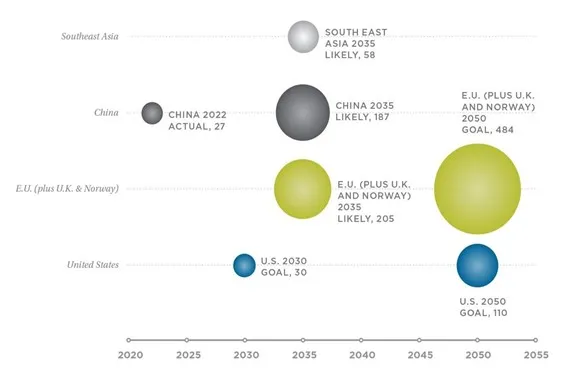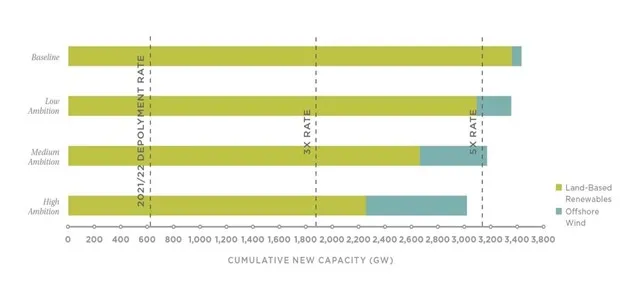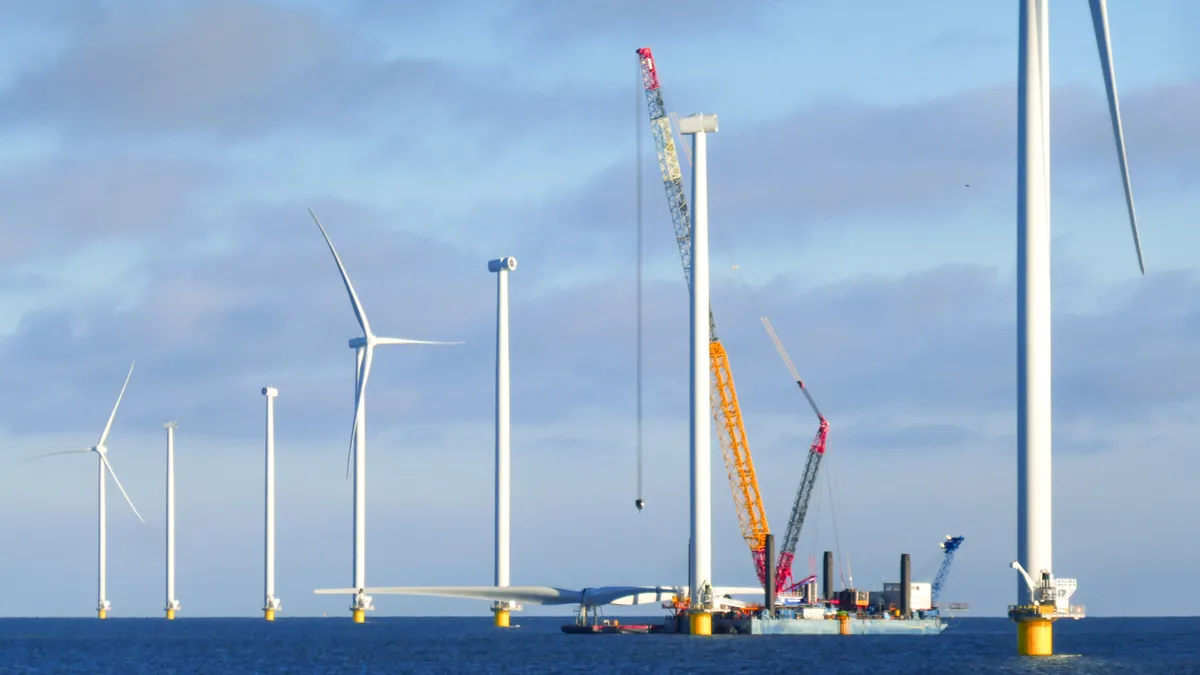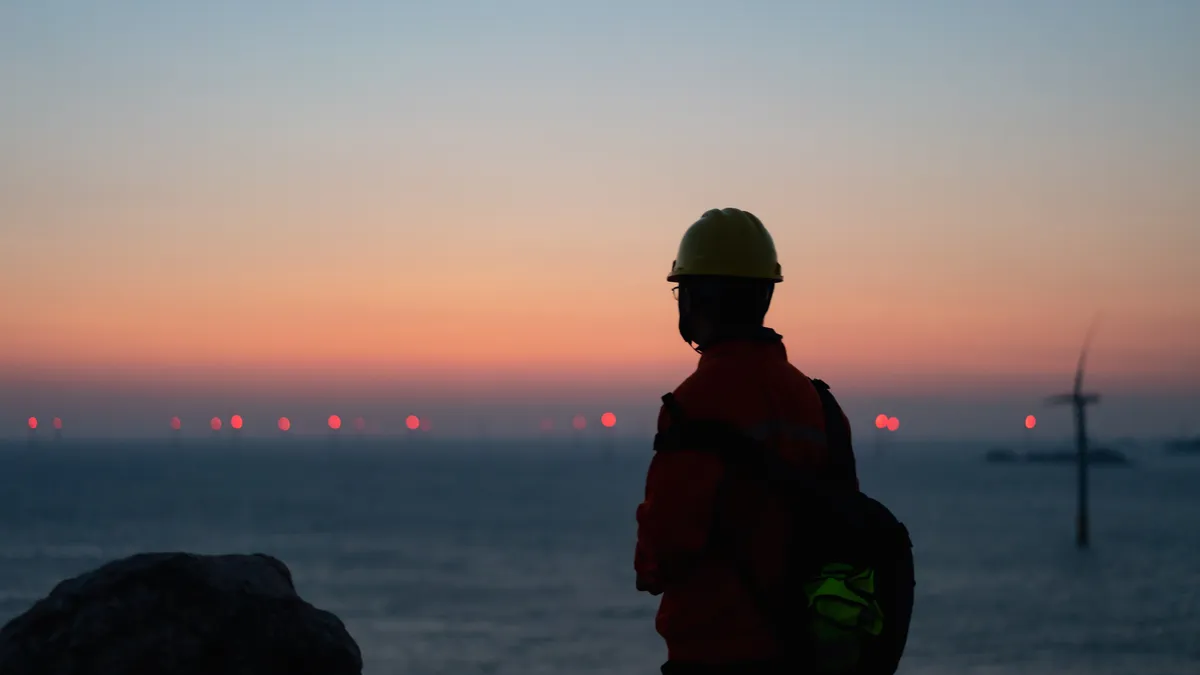Taylor McNair is a program manager at GridLab.
In June, the nation’s first large-scale offshore wind farm began construction 15 miles off the coast of Massachusetts, ushering in a new era of renewable energy development in the United States. Once complete, Vineyard Wind I will provide 800 MW of new clean energy capacity, enough to power 400,000 homes and businesses. It’s the first real step toward achieving the Biden administration’s target of 30 GW of offshore wind by 2030.
But the nascent U.S. offshore wind industry is also facing headwinds from inflation, constrained supply chains, and rising interest rates. Developers have re-bid projects at higher prices leading some to question the industry’s long-term viability.
New research from my organization, GridLab, along with UC Berkeley and Energy Innovation, suggests that the long-term prospects for offshore wind remain promising as a result of improving technology and falling costs. In fact, U.S. offshore wind ambition should be far higher — billions in investment and hundreds of thousands of new jobs, along with a stable and clean grid, are at stake.
Today’s prices spikes are like the early days of land-based solar and wind, which after reaching maturity are now America’s cheapest forms of electricity. Establishing a robust domestic offshore wind supply chain now will drive down prices as more turbines are built, and technological advancements will set the industry up for success.
Our new report, 2035 and Beyond: Abundant, Affordable Offshore Wind Can Accelerate Our Clean Electricity Future, is the third report in the 2035 Report series and a roadmap for offshore wind to provide up to 25% of total U.S. electricity generation by 2050. It shows the technology can play an integral role in the nation’s transition to 100% clean electricity and net zero emissions, while creating up to 390,000 new jobs and attracting $1.8 trillion in investment that can revitalize our port communities, kickstart manufacturing, and keep electricity costs low.
Offshore wind is surging worldwide as technology prices fall — the global pipeline has sailed past 700 GW. A group of European nations have set targets to install at least 120 GW of offshore wind in the North Sea by 2030 and 300 GW by 2050. China added nearly 20 GW of offshore wind in the last two years alone — and now boasts nearly half of all installed offshore wind capacity in the world. Matching this deployment ambition in the U.S. would require a national offshore wind target of 400-500 GW by 2050.

We’ll need that extra capacity. Increased electrification will push total electricity demand from 4,000 terawatt hours today to over 10,000 TWh by 2050. The U.S. must substantially increase annual deployments of clean energy resources to meet that rising demand for clean power generation. In our Mid Ambition scenario, we envision the U.S. deploying 100 GW of offshore wind by 2035 and 500 GW by 2050, accompanied by over 2,500 GW of land-based renewables. The combination of these clean resources, plus green hydrogen and other existing renewables, can provide 95% of total power generation in 2050.
Offshore wind is not a silver bullet to solving our decarbonization challenges. However, stretching our offshore wind investments diversifies our energy mix, blazing new paths toward net zero as we phase out fossil fuel generation. To achieve near-net zero emissions by 2050, the U.S. will need to add approximately 100 GW of land-based wind and solar per year, plus 27 GW of offshore wind annually between 2035-2050. That’s nearly four times the amount of renewables deployed in 2021. But without 500 GW of offshore wind, the necessary land-based renewables installation rate jumps to nearly six times today’s deployment levels.

Meanwhile, the transmission system will need to expand and evolve to integrate new renewable resources. Offshore wind presents an opportunity to rethink existing transmission planning processes that have stymied land-based renewables. Coordinated offshore transmission planning — where multiple offshore wind plants are clustered together and energy is transmitted to a single onshore grid connection — could reduce offshore interconnection costs 35%. Clustering requires fewer collection points, cutting total infrastructure needs and overall energy losses. This improves developer certainty, reduces seabed disturbances and other environmental impacts, and enables access to higher quality offshore wind sites further from the coast.
Offshore wind can be cost-effectively deployed not just along the East Coast, where steel is already in the water, but across the Southeast Atlantic, Gulf of Mexico, Pacific Coast, and Great Lakes. This abundant coastal offshore wind geography can be home to vast amounts of new offshore turbines while avoiding sensitive environmental areas, critical fisheries, and other existing infrastructure. In fact, we estimate that the foundations and turbines supporting 750 GW of offshore wind in 2050 would comprise less than 1% of the total available area suitable for development in the U.S. Exclusive Economic Zone.
But all this upside requires federal and state governments to establish more ambitious offshore wind goals aligning with a net zero future amid increased electricity demand. The federal government must accelerate offshore wind site identification and assessment — including environmental analysis and robust stakeholder engagement — in order to hasten permitting processes.
While fossil fuel advocates say recent whale deaths raise concerns about the impacts of offshore wind, federal and state scientists have clearly stated there is no connection to offshore wind activities. In fact, much of the “local” opposition to offshore wind deployment is funded by the oil and gas industry. The offshore wind sector is undertaking the largest investment in ocean monitoring and data collection in recent history, and it must invest in community engagement, protect ecosystems, and adapt projects to maintain industry growth.
Perhaps most importantly, the federal government must continue incentivizing local supply chain development, particularly manufacturing facilities, port infrastructure, and vessel construction. Federal policy action can also prepare the workforce for offshore wind development if the U.S. Departments of Labor and Energy help state governments and labor unions expand apprenticeship opportunities, upskilling, training, and assessing future workforce needs.
As we write this, a punishing heat wave is gripping most of the U.S., Asia, and Europe in a grim reminder we’ve no time to waste deploying proven climate solutions.
While the U.S. continues to decarbonize its electric sector, reaching net zero emissions and mitigating the worst impacts of climate change will require unprecedented new amounts of clean energy generation. By investing in offshore wind today, we’ll navigate our decarbonization challenges by diversifying U.S. energy supplies on the pathway to 100% clean electricity and net zero emissions.






















